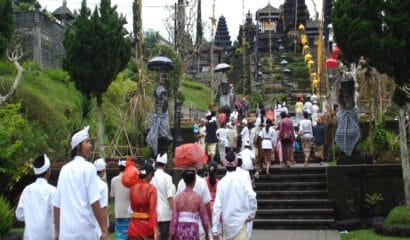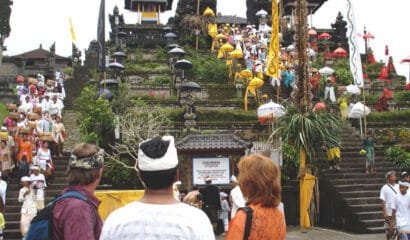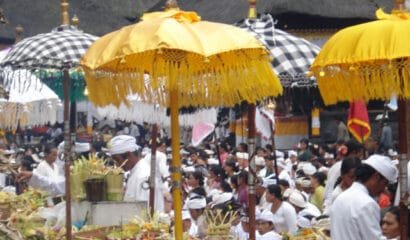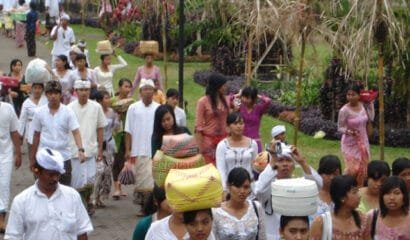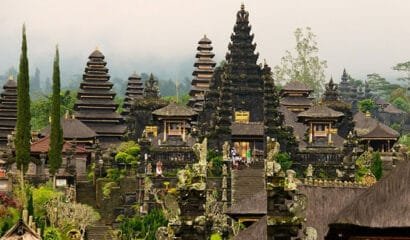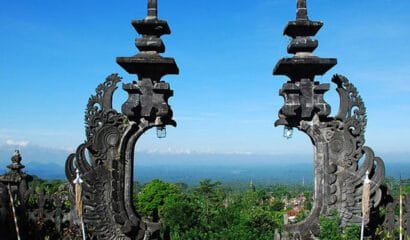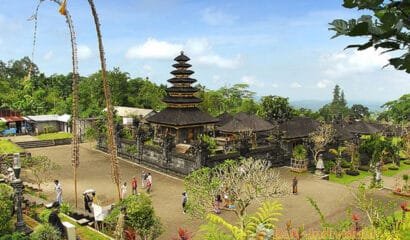The holiest and most important temple on Bali is Pura Besakih or Besakih Temple, situated on the slopes of Bali’s sacred Mount Agung. Twinned with Mount Batur to the north-west, Agung is the highest mountain on the island, rising to 3,140 m. It is easiest to approach Besakih by taking the road north from Klungkung, a distance of 22 km. However, there are also two east-west roads, linking the Klungkung route to Besakih with Bangli in the west and Amlapura in the east.
Besakih Temple is not one temple, but a complex of 22 puras that lie scattered over the south slopes of Mount Agung at an altitude of about 950 m. Besakih Temple is also the biggest Hindu temple in Bali with full of religious ambience and decorated by Bali style ornaments from the doorstep temple, holy idol made from stone, gate building joining with others to boost high etc.
The name of besakih made from “basuki”, which means congrats. It owns the breathtaking view and active daily Balinese Hindu with their religious activities
Architecture
This Mother Temple is actually a complex made up of twenty-two temples that sit on parallel ridges. It has stepped terraces and flights of stairs which ascend to a number of courtyards and brick gateways that in turn lead up to the main spire or Meru structure, which is called Pura Penataran Agung. All this is aligned along a single axis and designed to lead the spiritual person upward and closer to the mountain which is considered sacred.
The main sanctuary of the complex is the Pura Penataran Agung. It is the central, largest, most important and also the Mother Temple of all Bali. It is here that every Balinese, whatever his or her clan or class, can some to worship – although in the past it was reserved for the Royal Families of Klungkung. The symbolic center of the main sanctuary is the lotus throne or padmasana, which is therefore the ritual focus of the entire complex. It dates to around the seventeenth century. The other 21 temples that sprawl across the slopes of Mount Agung surrounding the Mother Temple are linked to particular clans.
History
Mount Agung is an active volcano and the last series of eruptions in 1963, which killed approximately 1.700 peoples, also threatened Pura Besakih. The lava flows missed the temple complex by mere meters. The saving of the temple is regarded by the Balinese people as miraculous, and a signal from the gods that they wished to demonstrate their power but not destroy the monument the Balinese faithful had erected.
The Pura Penataran Agung is most visitors refer to as Pura Besakih, is dedicated to Siva and was probably a pre-Indic terraced sanctuary. An indication that the pura is of great antiquity and pre-dates the arrival of Hinduism in Bali is the use of Old Indonesian and Old Balinese to name some of the Gods that are worshipped here. Since then, it has seen many changes. It seems that the Temple was enlarged during the reign of King Dharmavangsa (1022-1026).
But the most significant changes occurred after 1343 when Gajah Mada of the Majapahit Kingdom of Java, sent a force to subdue the ‘infamous and odious’ ruler of Bali. With the victory of the Majapahit army, viceroys were sent from Java to rule the Island. A descendant of one of these men established himself as the Prince of Gelgel and this Royal family became closely associated with Besakih, making it their ancestral pura. The merus were probably added at this time.
Festivals
Each year there are at least seventy festivals held at the complex, since almost every shrine celebrates a yearly anniversary. This cycle is based on the 210-day Balinese calendar year. It had been nominated as a World Heritage Site as early as 1995, but remains unvested.
The once a century Eka Dasa Rudra is the most important Hindu Festival in Indonesia. It is held when, according to the Hindu saka calendar, the year ends in two zeros. However it can also be held when natural, political or economic calamity or disturbance is such that one needs to be called. For example’s the events of the Indonesian Revolution (1945-1949). Eka Dasa Rudra is not just one festival, but a series of many. The most important is the purification sacrifice, or Taur Eka Dasa Rudra, which occurs on the last day of a saka century – saka 1900 fell, for example on 28 March 1979. During the course of the festival large numbers of animals were brought up to Besakih for sacrifice – about 60 species in all. It was not a reassuring sight for conversations, as among the creatures were tiger cubs and rare eagles. DS Fox writes a book about the festival, “Once a century: Pura Besakih and the Eka Dasa Rudra Festival (1982)”.
There are a lot of temples inside Besakih:
1. Pesimpangan Temple
2. Dalem Puri Temple
3. Manik Mas Temple
4. Bangun Sakti Temple
5. Ulun Kulkul Temple
6. Merajan Selonding Temple
7. Goa Temple
8. Banua Kawan Temple
9. Merajan Kanginan Temple
10. Hyang Haluh (Jenggala Temple) Temple
11. Basukihan Temple
12. Penataran Agung Temple
13. Batu Madeg Temple
14. Batu Kiduling Kreteg Temple
15. Gelap Temple
16. Pengubengan Temple
17. Batu Tirtha Temple
18. Batu Peninjoan Temple
19. Pedarman Temple Complex


